Management Operations: Leadership and Management in Debenhams
VerifiedAdded on 2023/04/24
|19
|2611
|382
Report
AI Summary
This report focuses on management and leadership within Debenhams, examining the roles, functions, and characteristics of managers and leaders, including planning, organizing, directing, and controlling. It explores various management and leadership theories that can enhance organizational efficiency and effectiveness. The report defines management and leadership, compares leaders and managers in the Debenhams context, and analyzes the strengths and weaknesses of different approaches used by managers and leaders in various situations. It also includes a PowerPoint presentation summarizing key management theories, leadership styles, and tools like Six Sigma, emphasizing the roles of leaders and managers in operational management and corporate culture.
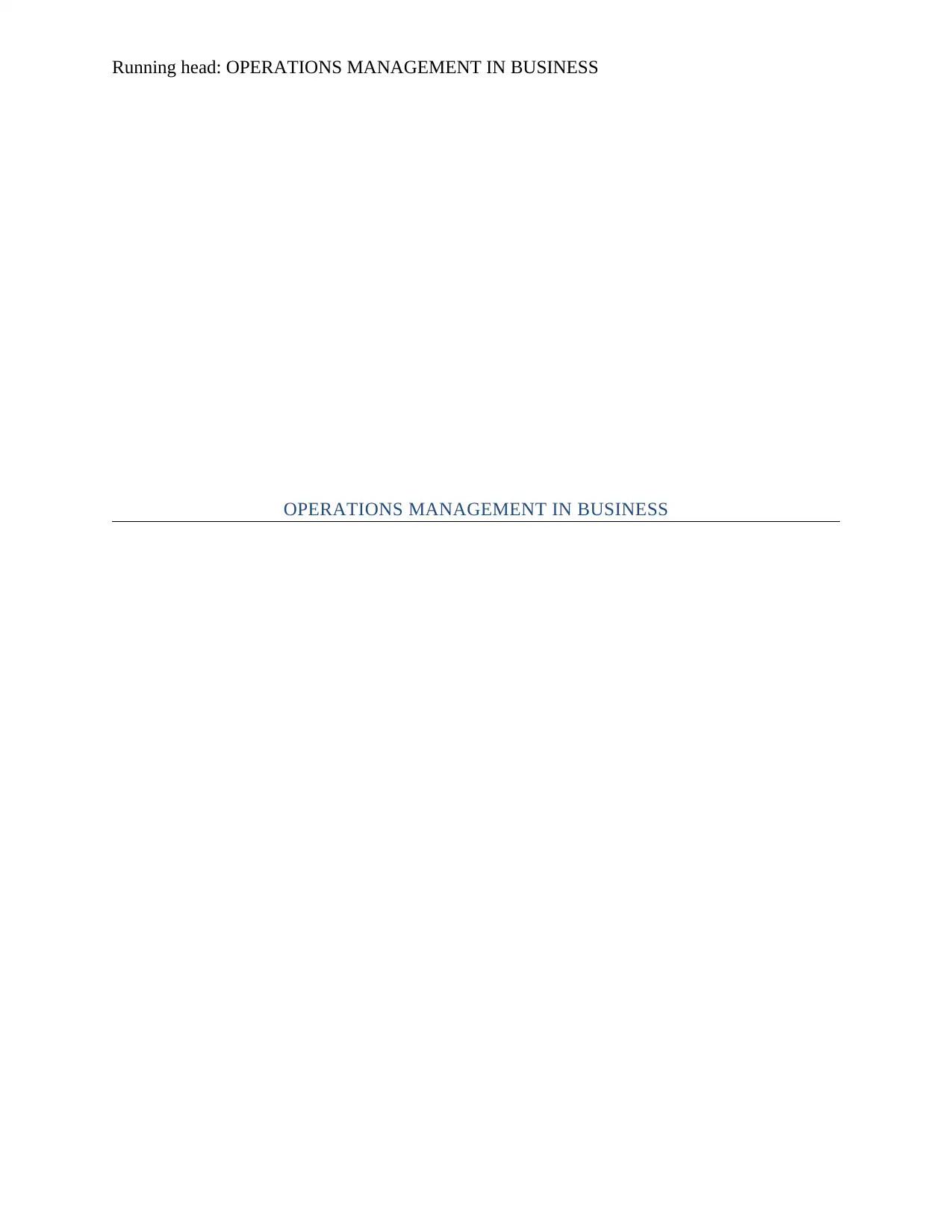
Running head: OPERATIONS MANAGEMENT IN BUSINESS
OPERATIONS MANAGEMENT IN BUSINESS
OPERATIONS MANAGEMENT IN BUSINESS
Paraphrase This Document
Need a fresh take? Get an instant paraphrase of this document with our AI Paraphraser
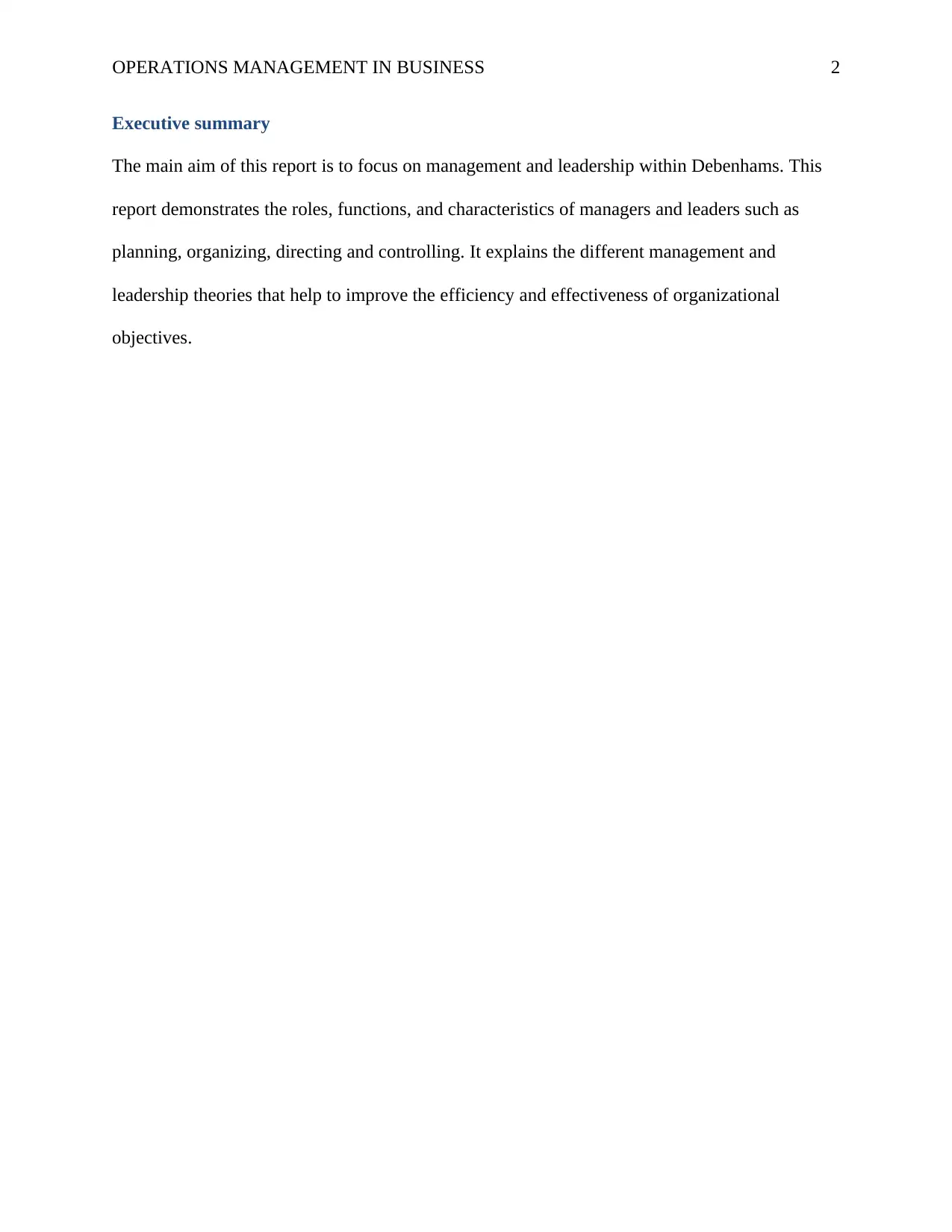
OPERATIONS MANAGEMENT IN BUSINESS 2
Executive summary
The main aim of this report is to focus on management and leadership within Debenhams. This
report demonstrates the roles, functions, and characteristics of managers and leaders such as
planning, organizing, directing and controlling. It explains the different management and
leadership theories that help to improve the efficiency and effectiveness of organizational
objectives.
Executive summary
The main aim of this report is to focus on management and leadership within Debenhams. This
report demonstrates the roles, functions, and characteristics of managers and leaders such as
planning, organizing, directing and controlling. It explains the different management and
leadership theories that help to improve the efficiency and effectiveness of organizational
objectives.
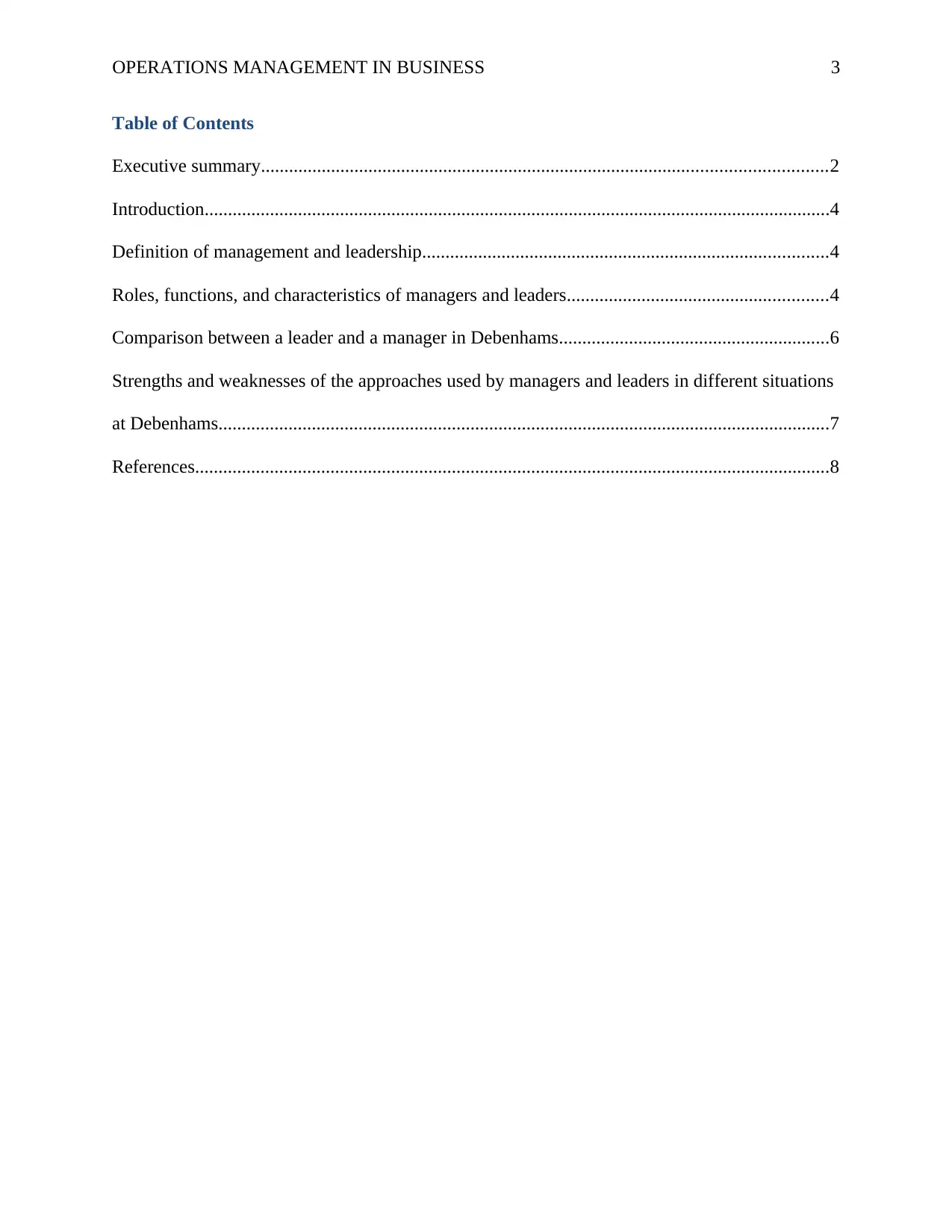
OPERATIONS MANAGEMENT IN BUSINESS 3
Table of Contents
Executive summary.........................................................................................................................2
Introduction......................................................................................................................................4
Definition of management and leadership.......................................................................................4
Roles, functions, and characteristics of managers and leaders........................................................4
Comparison between a leader and a manager in Debenhams..........................................................6
Strengths and weaknesses of the approaches used by managers and leaders in different situations
at Debenhams...................................................................................................................................7
References........................................................................................................................................8
Table of Contents
Executive summary.........................................................................................................................2
Introduction......................................................................................................................................4
Definition of management and leadership.......................................................................................4
Roles, functions, and characteristics of managers and leaders........................................................4
Comparison between a leader and a manager in Debenhams..........................................................6
Strengths and weaknesses of the approaches used by managers and leaders in different situations
at Debenhams...................................................................................................................................7
References........................................................................................................................................8
⊘ This is a preview!⊘
Do you want full access?
Subscribe today to unlock all pages.

Trusted by 1+ million students worldwide
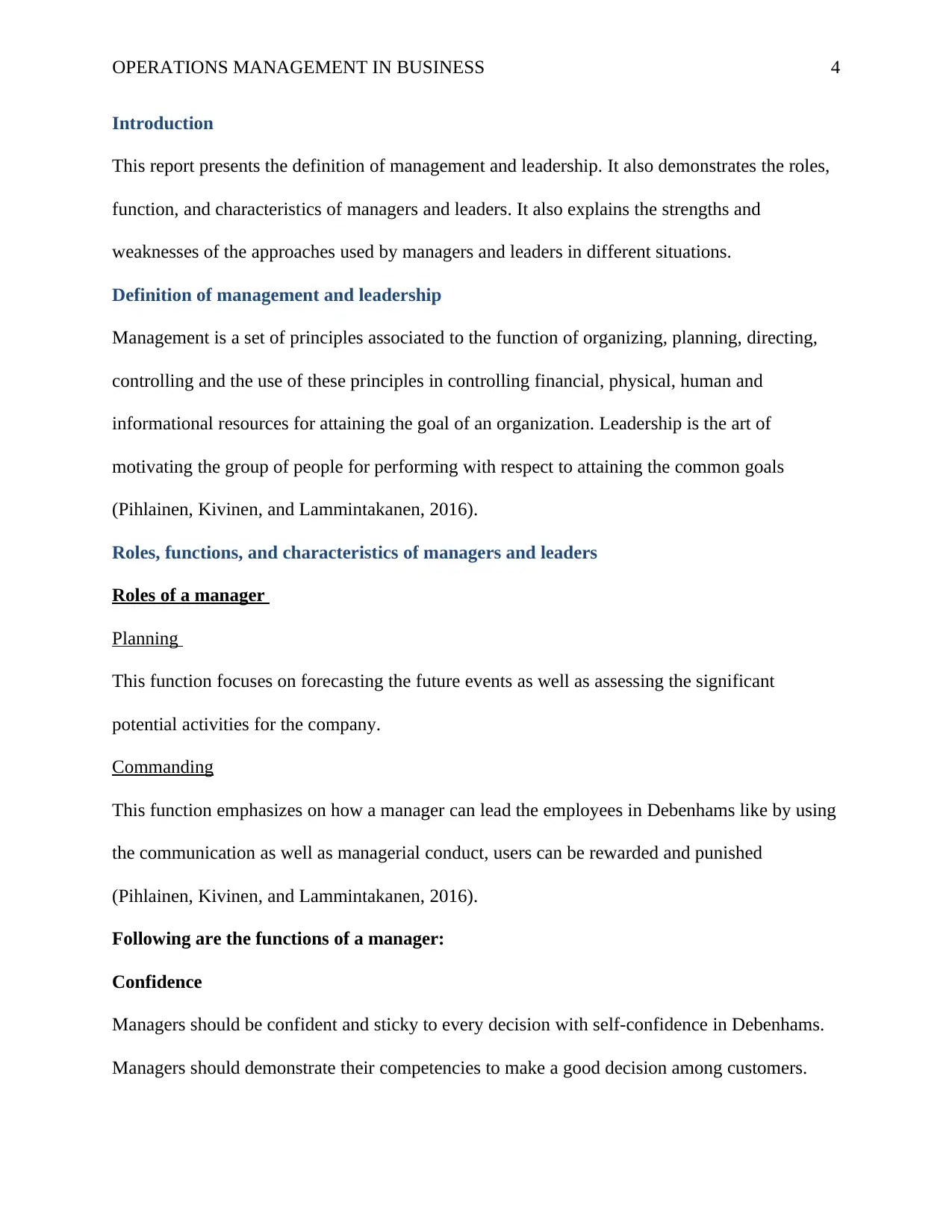
OPERATIONS MANAGEMENT IN BUSINESS 4
Introduction
This report presents the definition of management and leadership. It also demonstrates the roles,
function, and characteristics of managers and leaders. It also explains the strengths and
weaknesses of the approaches used by managers and leaders in different situations.
Definition of management and leadership
Management is a set of principles associated to the function of organizing, planning, directing,
controlling and the use of these principles in controlling financial, physical, human and
informational resources for attaining the goal of an organization. Leadership is the art of
motivating the group of people for performing with respect to attaining the common goals
(Pihlainen, Kivinen, and Lammintakanen, 2016).
Roles, functions, and characteristics of managers and leaders
Roles of a manager
Planning
This function focuses on forecasting the future events as well as assessing the significant
potential activities for the company.
Commanding
This function emphasizes on how a manager can lead the employees in Debenhams like by using
the communication as well as managerial conduct, users can be rewarded and punished
(Pihlainen, Kivinen, and Lammintakanen, 2016).
Following are the functions of a manager:
Confidence
Managers should be confident and sticky to every decision with self-confidence in Debenhams.
Managers should demonstrate their competencies to make a good decision among customers.
Introduction
This report presents the definition of management and leadership. It also demonstrates the roles,
function, and characteristics of managers and leaders. It also explains the strengths and
weaknesses of the approaches used by managers and leaders in different situations.
Definition of management and leadership
Management is a set of principles associated to the function of organizing, planning, directing,
controlling and the use of these principles in controlling financial, physical, human and
informational resources for attaining the goal of an organization. Leadership is the art of
motivating the group of people for performing with respect to attaining the common goals
(Pihlainen, Kivinen, and Lammintakanen, 2016).
Roles, functions, and characteristics of managers and leaders
Roles of a manager
Planning
This function focuses on forecasting the future events as well as assessing the significant
potential activities for the company.
Commanding
This function emphasizes on how a manager can lead the employees in Debenhams like by using
the communication as well as managerial conduct, users can be rewarded and punished
(Pihlainen, Kivinen, and Lammintakanen, 2016).
Following are the functions of a manager:
Confidence
Managers should be confident and sticky to every decision with self-confidence in Debenhams.
Managers should demonstrate their competencies to make a good decision among customers.
Paraphrase This Document
Need a fresh take? Get an instant paraphrase of this document with our AI Paraphraser
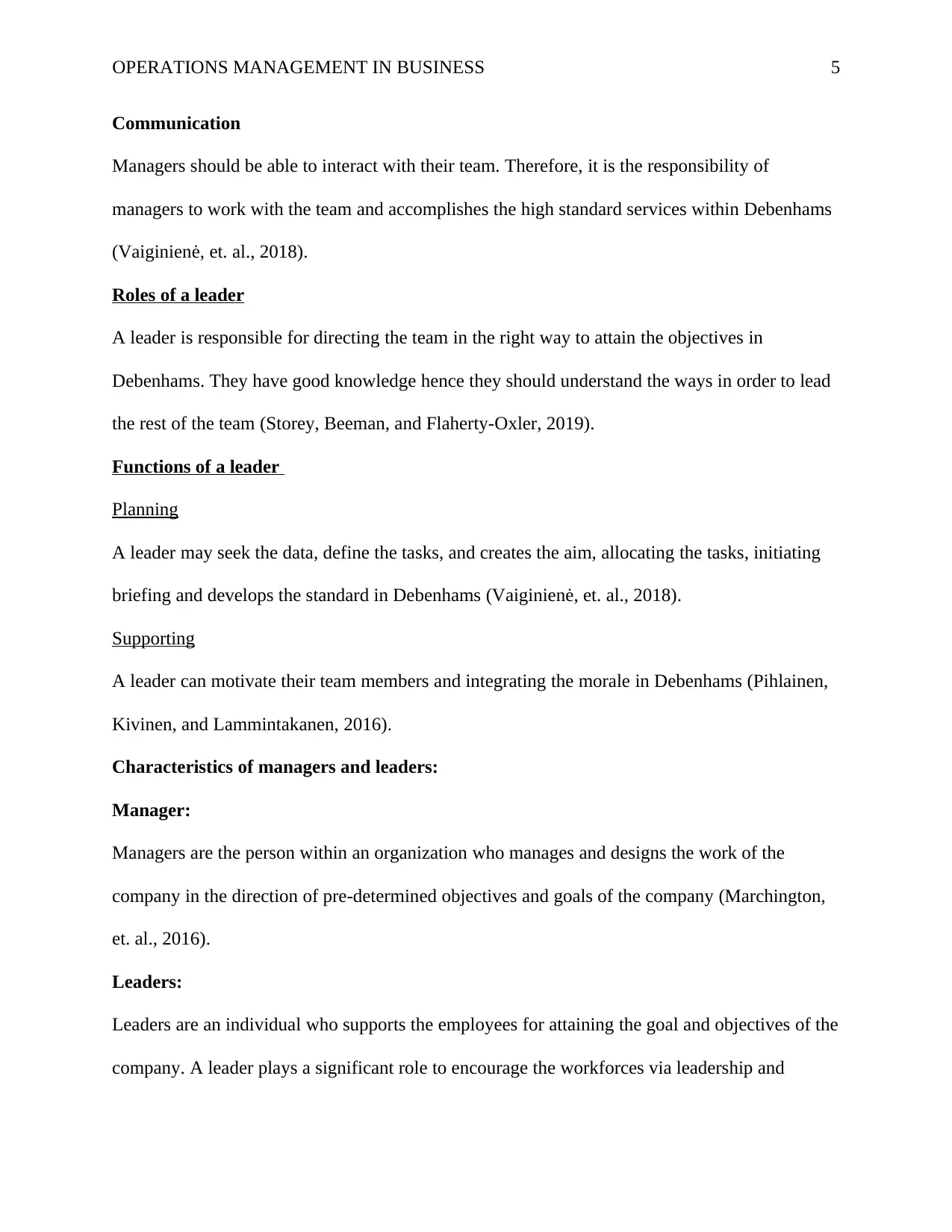
OPERATIONS MANAGEMENT IN BUSINESS 5
Communication
Managers should be able to interact with their team. Therefore, it is the responsibility of
managers to work with the team and accomplishes the high standard services within Debenhams
(Vaiginienė, et. al., 2018).
Roles of a leader
A leader is responsible for directing the team in the right way to attain the objectives in
Debenhams. They have good knowledge hence they should understand the ways in order to lead
the rest of the team (Storey, Beeman, and Flaherty-Oxler, 2019).
Functions of a leader
Planning
A leader may seek the data, define the tasks, and creates the aim, allocating the tasks, initiating
briefing and develops the standard in Debenhams (Vaiginienė, et. al., 2018).
Supporting
A leader can motivate their team members and integrating the morale in Debenhams (Pihlainen,
Kivinen, and Lammintakanen, 2016).
Characteristics of managers and leaders:
Manager:
Managers are the person within an organization who manages and designs the work of the
company in the direction of pre-determined objectives and goals of the company (Marchington,
et. al., 2016).
Leaders:
Leaders are an individual who supports the employees for attaining the goal and objectives of the
company. A leader plays a significant role to encourage the workforces via leadership and
Communication
Managers should be able to interact with their team. Therefore, it is the responsibility of
managers to work with the team and accomplishes the high standard services within Debenhams
(Vaiginienė, et. al., 2018).
Roles of a leader
A leader is responsible for directing the team in the right way to attain the objectives in
Debenhams. They have good knowledge hence they should understand the ways in order to lead
the rest of the team (Storey, Beeman, and Flaherty-Oxler, 2019).
Functions of a leader
Planning
A leader may seek the data, define the tasks, and creates the aim, allocating the tasks, initiating
briefing and develops the standard in Debenhams (Vaiginienė, et. al., 2018).
Supporting
A leader can motivate their team members and integrating the morale in Debenhams (Pihlainen,
Kivinen, and Lammintakanen, 2016).
Characteristics of managers and leaders:
Manager:
Managers are the person within an organization who manages and designs the work of the
company in the direction of pre-determined objectives and goals of the company (Marchington,
et. al., 2016).
Leaders:
Leaders are an individual who supports the employees for attaining the goal and objectives of the
company. A leader plays a significant role to encourage the workforces via leadership and
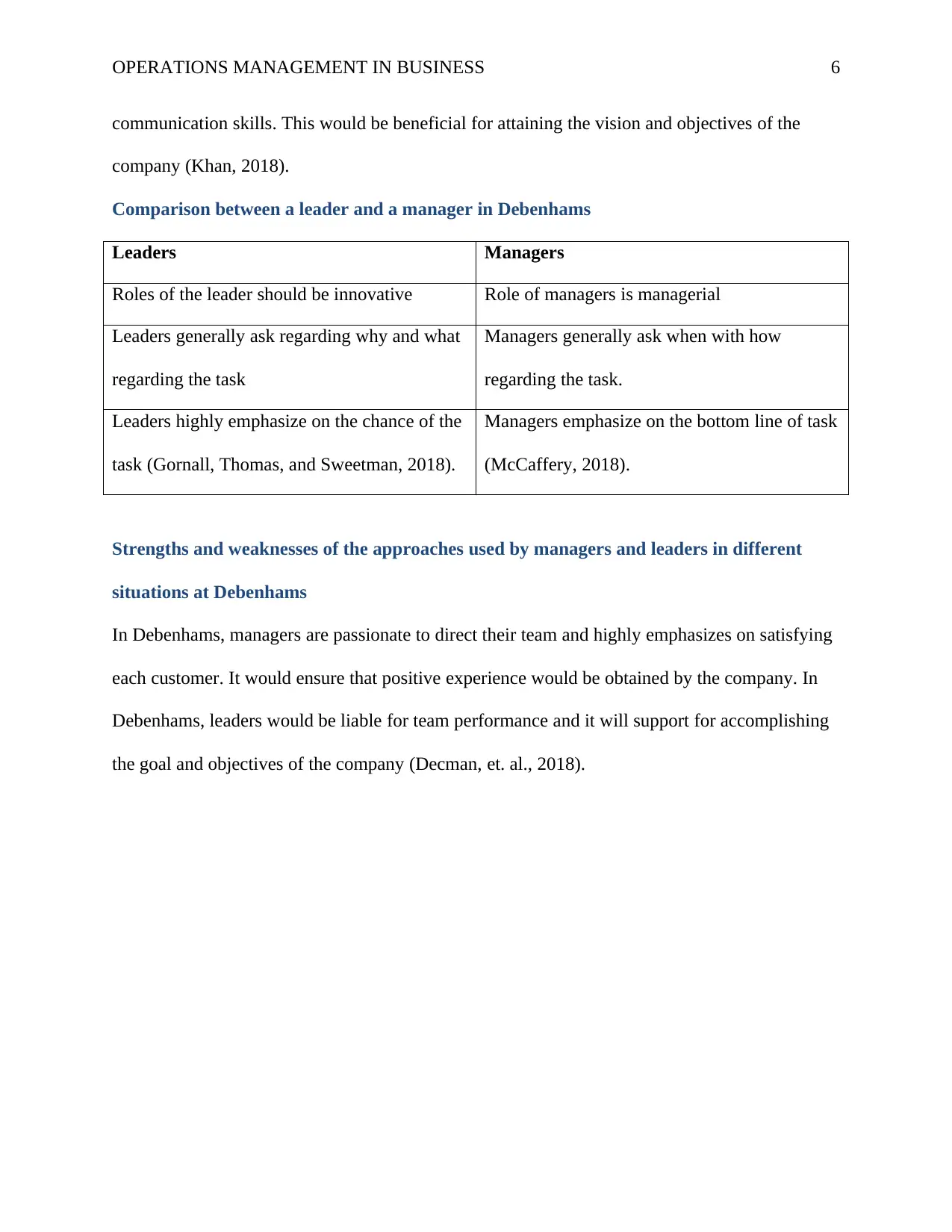
OPERATIONS MANAGEMENT IN BUSINESS 6
communication skills. This would be beneficial for attaining the vision and objectives of the
company (Khan, 2018).
Comparison between a leader and a manager in Debenhams
Leaders Managers
Roles of the leader should be innovative Role of managers is managerial
Leaders generally ask regarding why and what
regarding the task
Managers generally ask when with how
regarding the task.
Leaders highly emphasize on the chance of the
task (Gornall, Thomas, and Sweetman, 2018).
Managers emphasize on the bottom line of task
(McCaffery, 2018).
Strengths and weaknesses of the approaches used by managers and leaders in different
situations at Debenhams
In Debenhams, managers are passionate to direct their team and highly emphasizes on satisfying
each customer. It would ensure that positive experience would be obtained by the company. In
Debenhams, leaders would be liable for team performance and it will support for accomplishing
the goal and objectives of the company (Decman, et. al., 2018).
communication skills. This would be beneficial for attaining the vision and objectives of the
company (Khan, 2018).
Comparison between a leader and a manager in Debenhams
Leaders Managers
Roles of the leader should be innovative Role of managers is managerial
Leaders generally ask regarding why and what
regarding the task
Managers generally ask when with how
regarding the task.
Leaders highly emphasize on the chance of the
task (Gornall, Thomas, and Sweetman, 2018).
Managers emphasize on the bottom line of task
(McCaffery, 2018).
Strengths and weaknesses of the approaches used by managers and leaders in different
situations at Debenhams
In Debenhams, managers are passionate to direct their team and highly emphasizes on satisfying
each customer. It would ensure that positive experience would be obtained by the company. In
Debenhams, leaders would be liable for team performance and it will support for accomplishing
the goal and objectives of the company (Decman, et. al., 2018).
⊘ This is a preview!⊘
Do you want full access?
Subscribe today to unlock all pages.

Trusted by 1+ million students worldwide

OPERATIONS MANAGEMENT IN BUSINESS 7
References
Decman, J.M., Badgett, K., Shaughnessy, B., Randall, A., Nixon, L. and Lemley, B., 2018.
Organizational leadership through management: Superintendent perceptions. Educational
Management Administration & Leadership, 46(6), pp.997-1013.
Gornall, L., Thomas, B. and Sweetman, L. eds., 2018. Exploring Consensual Leadership in
Higher Education: Co-operation, Collaboration, and Partnership. Bloomsbury Publishing.
Khan, M.Y.H., 2018. Cross cultural leadership and the hospitality industry: a leadership style
towards success in organizational goals in France. Hos Tour Manage Int, 1(4), pp.20-25.
Marchington, M., Wilkinson, A., Donnelly, R. and Kynighou, A., 2016. Human resource
management at work. USA: Kogan Page Publishers.
McCaffery, P., 2018. The higher education manager's handbook: effective leadership and
management in universities and colleges. UK: Routledge.
Pihlainen, V., Kivinen, T. and Lammintakanen, J., 2016. Management and leadership
competence in hospitals: a systematic literature review. Leadership in Health Services, 29(1),
pp.95-110.
Storey, V.A., Beeman, T.E. and Flaherty-Oxler, K., 2019. Developing a Clinical Leadership
Pipeline: Planning, Operation, and Sustainability. In Preparing Physicians to Lead in the 21st
Century (pp. 164-182). USA: IGI Global.
Vaiginienė, E., Alonderienė, R., Pilkienė, M., Ramonienė, L., Savanevičienė, A. and
Stankevičiūtė, Ž., 2018. Management and Leadership Development Needs: The Case of
Lithuania. In Business and Society (pp. 115-135). USA: Springer, Cham.
References
Decman, J.M., Badgett, K., Shaughnessy, B., Randall, A., Nixon, L. and Lemley, B., 2018.
Organizational leadership through management: Superintendent perceptions. Educational
Management Administration & Leadership, 46(6), pp.997-1013.
Gornall, L., Thomas, B. and Sweetman, L. eds., 2018. Exploring Consensual Leadership in
Higher Education: Co-operation, Collaboration, and Partnership. Bloomsbury Publishing.
Khan, M.Y.H., 2018. Cross cultural leadership and the hospitality industry: a leadership style
towards success in organizational goals in France. Hos Tour Manage Int, 1(4), pp.20-25.
Marchington, M., Wilkinson, A., Donnelly, R. and Kynighou, A., 2016. Human resource
management at work. USA: Kogan Page Publishers.
McCaffery, P., 2018. The higher education manager's handbook: effective leadership and
management in universities and colleges. UK: Routledge.
Pihlainen, V., Kivinen, T. and Lammintakanen, J., 2016. Management and leadership
competence in hospitals: a systematic literature review. Leadership in Health Services, 29(1),
pp.95-110.
Storey, V.A., Beeman, T.E. and Flaherty-Oxler, K., 2019. Developing a Clinical Leadership
Pipeline: Planning, Operation, and Sustainability. In Preparing Physicians to Lead in the 21st
Century (pp. 164-182). USA: IGI Global.
Vaiginienė, E., Alonderienė, R., Pilkienė, M., Ramonienė, L., Savanevičienė, A. and
Stankevičiūtė, Ž., 2018. Management and Leadership Development Needs: The Case of
Lithuania. In Business and Society (pp. 115-135). USA: Springer, Cham.
Paraphrase This Document
Need a fresh take? Get an instant paraphrase of this document with our AI Paraphraser
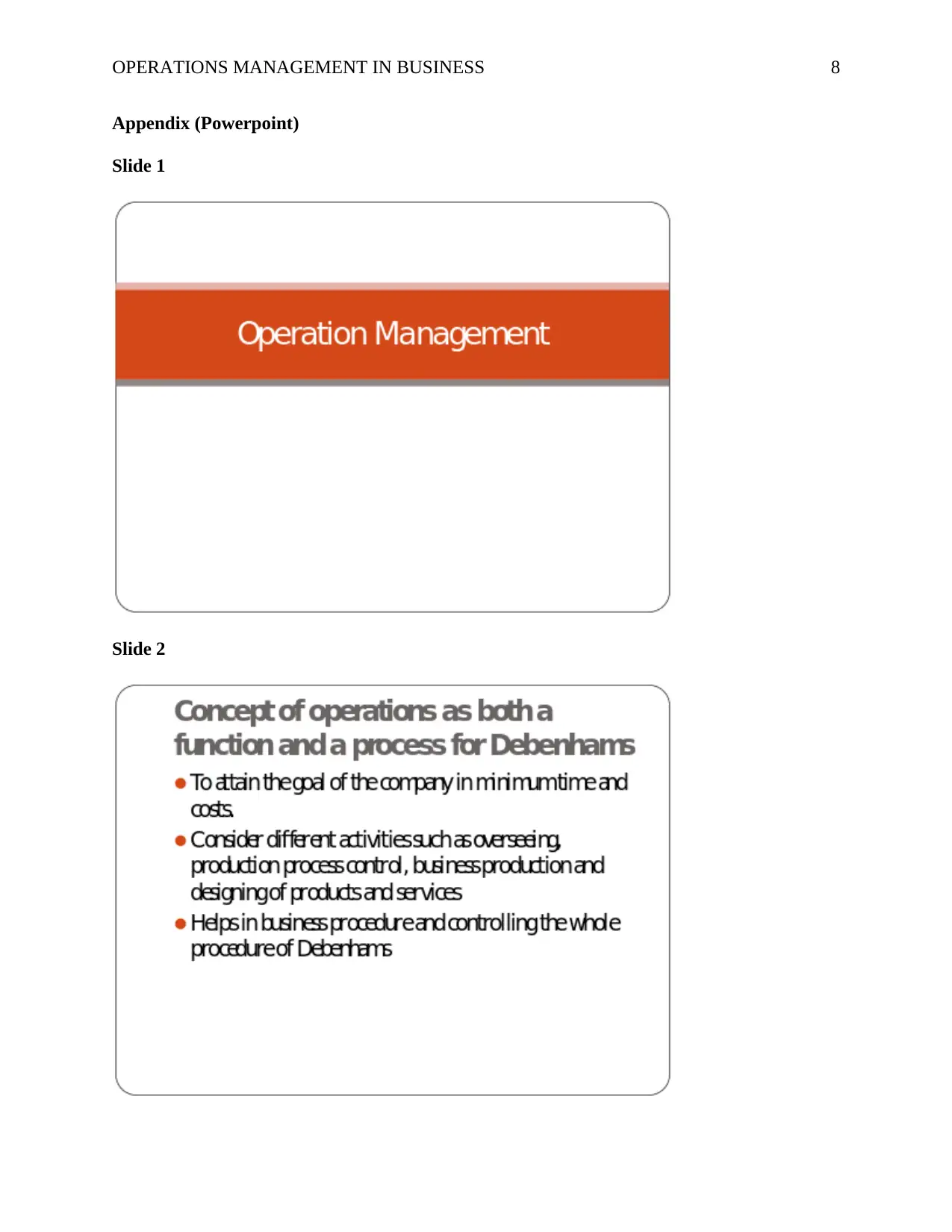
OPERATIONS MANAGEMENT IN BUSINESS 8
Appendix (Powerpoint)
Slide 1
Slide 2
Appendix (Powerpoint)
Slide 1
Slide 2
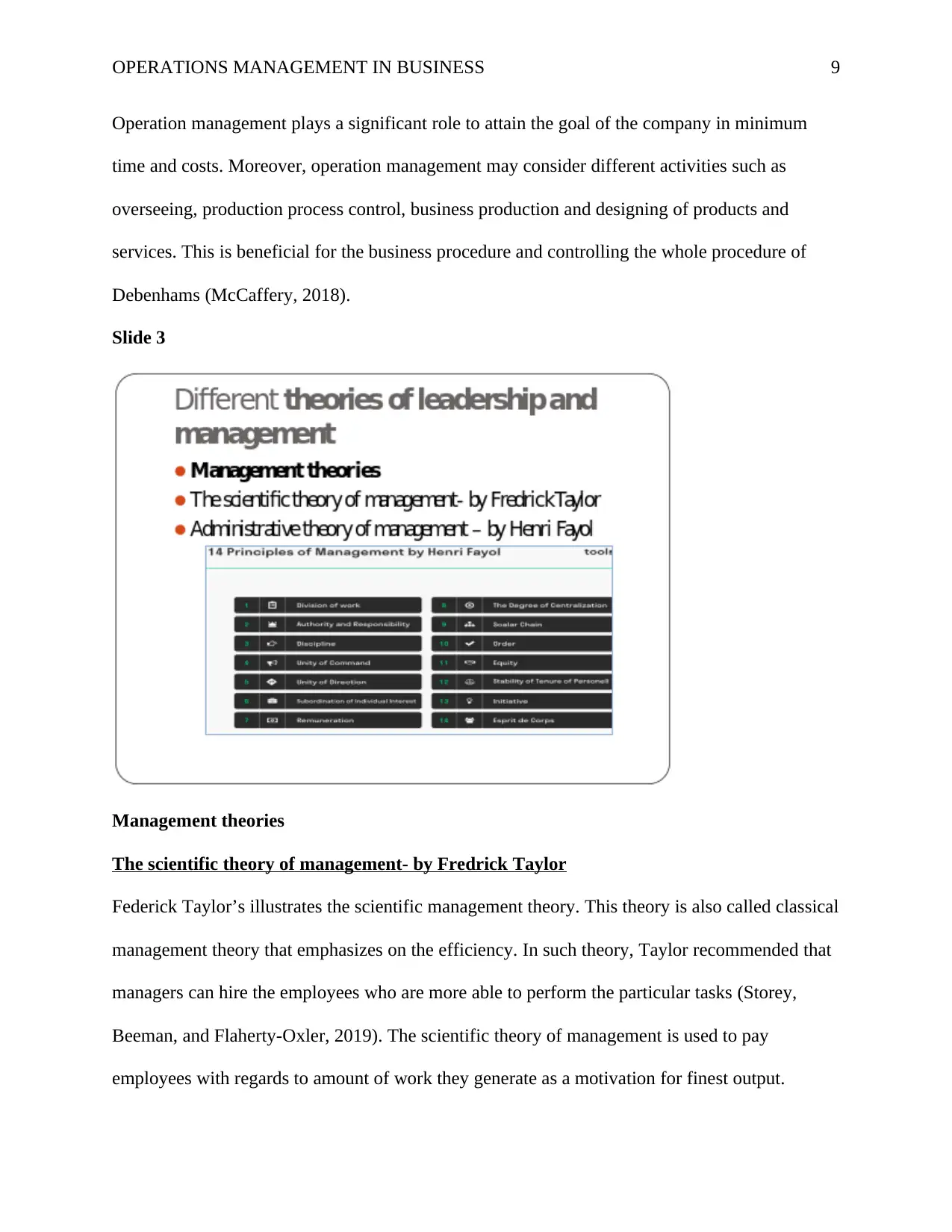
OPERATIONS MANAGEMENT IN BUSINESS 9
Operation management plays a significant role to attain the goal of the company in minimum
time and costs. Moreover, operation management may consider different activities such as
overseeing, production process control, business production and designing of products and
services. This is beneficial for the business procedure and controlling the whole procedure of
Debenhams (McCaffery, 2018).
Slide 3
Management theories
The scientific theory of management- by Fredrick Taylor
Federick Taylor’s illustrates the scientific management theory. This theory is also called classical
management theory that emphasizes on the efficiency. In such theory, Taylor recommended that
managers can hire the employees who are more able to perform the particular tasks (Storey,
Beeman, and Flaherty-Oxler, 2019). The scientific theory of management is used to pay
employees with regards to amount of work they generate as a motivation for finest output.
Operation management plays a significant role to attain the goal of the company in minimum
time and costs. Moreover, operation management may consider different activities such as
overseeing, production process control, business production and designing of products and
services. This is beneficial for the business procedure and controlling the whole procedure of
Debenhams (McCaffery, 2018).
Slide 3
Management theories
The scientific theory of management- by Fredrick Taylor
Federick Taylor’s illustrates the scientific management theory. This theory is also called classical
management theory that emphasizes on the efficiency. In such theory, Taylor recommended that
managers can hire the employees who are more able to perform the particular tasks (Storey,
Beeman, and Flaherty-Oxler, 2019). The scientific theory of management is used to pay
employees with regards to amount of work they generate as a motivation for finest output.
⊘ This is a preview!⊘
Do you want full access?
Subscribe today to unlock all pages.

Trusted by 1+ million students worldwide
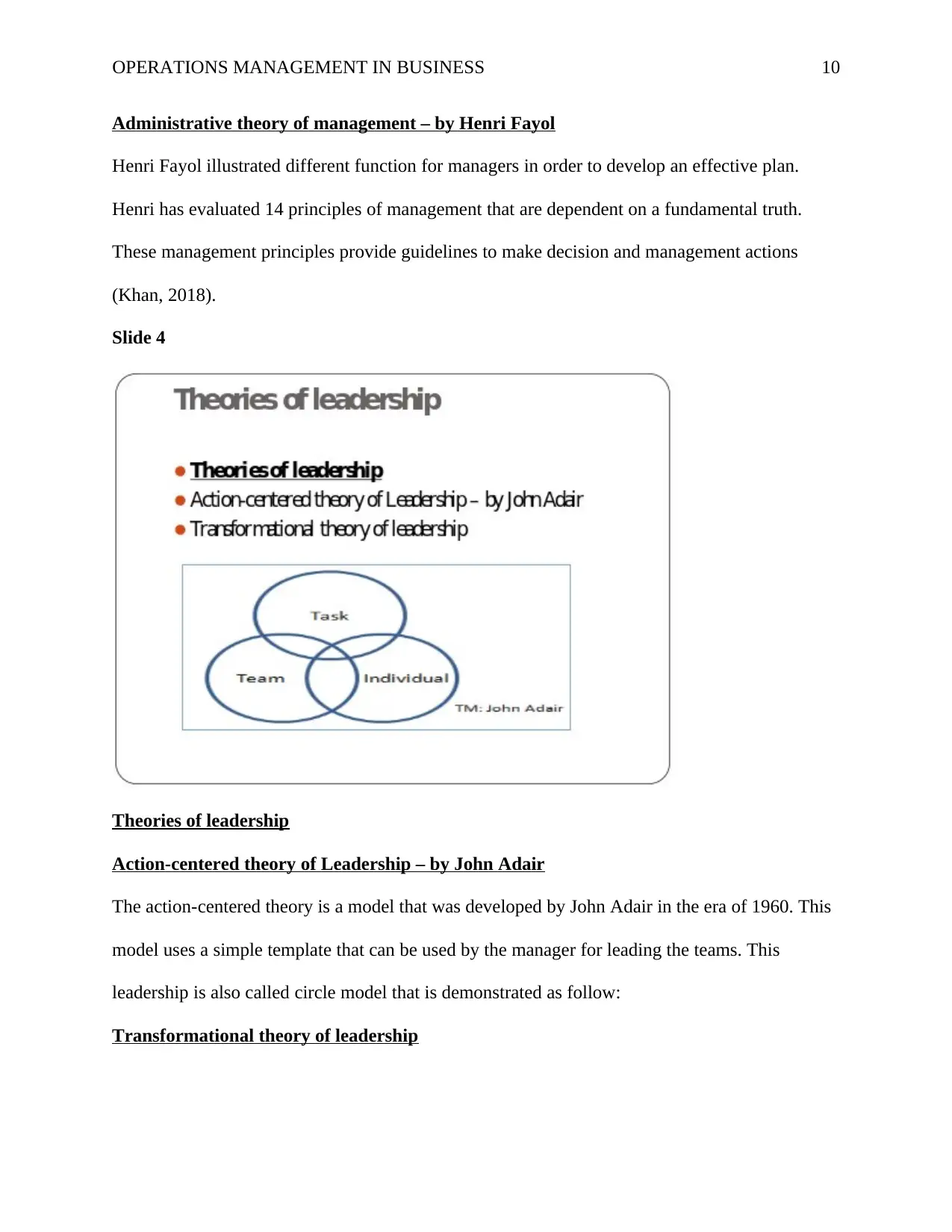
OPERATIONS MANAGEMENT IN BUSINESS 10
Administrative theory of management – by Henri Fayol
Henri Fayol illustrated different function for managers in order to develop an effective plan.
Henri has evaluated 14 principles of management that are dependent on a fundamental truth.
These management principles provide guidelines to make decision and management actions
(Khan, 2018).
Slide 4
Theories of leadership
Action-centered theory of Leadership – by John Adair
The action-centered theory is a model that was developed by John Adair in the era of 1960. This
model uses a simple template that can be used by the manager for leading the teams. This
leadership is also called circle model that is demonstrated as follow:
Transformational theory of leadership
Administrative theory of management – by Henri Fayol
Henri Fayol illustrated different function for managers in order to develop an effective plan.
Henri has evaluated 14 principles of management that are dependent on a fundamental truth.
These management principles provide guidelines to make decision and management actions
(Khan, 2018).
Slide 4
Theories of leadership
Action-centered theory of Leadership – by John Adair
The action-centered theory is a model that was developed by John Adair in the era of 1960. This
model uses a simple template that can be used by the manager for leading the teams. This
leadership is also called circle model that is demonstrated as follow:
Transformational theory of leadership
Paraphrase This Document
Need a fresh take? Get an instant paraphrase of this document with our AI Paraphraser
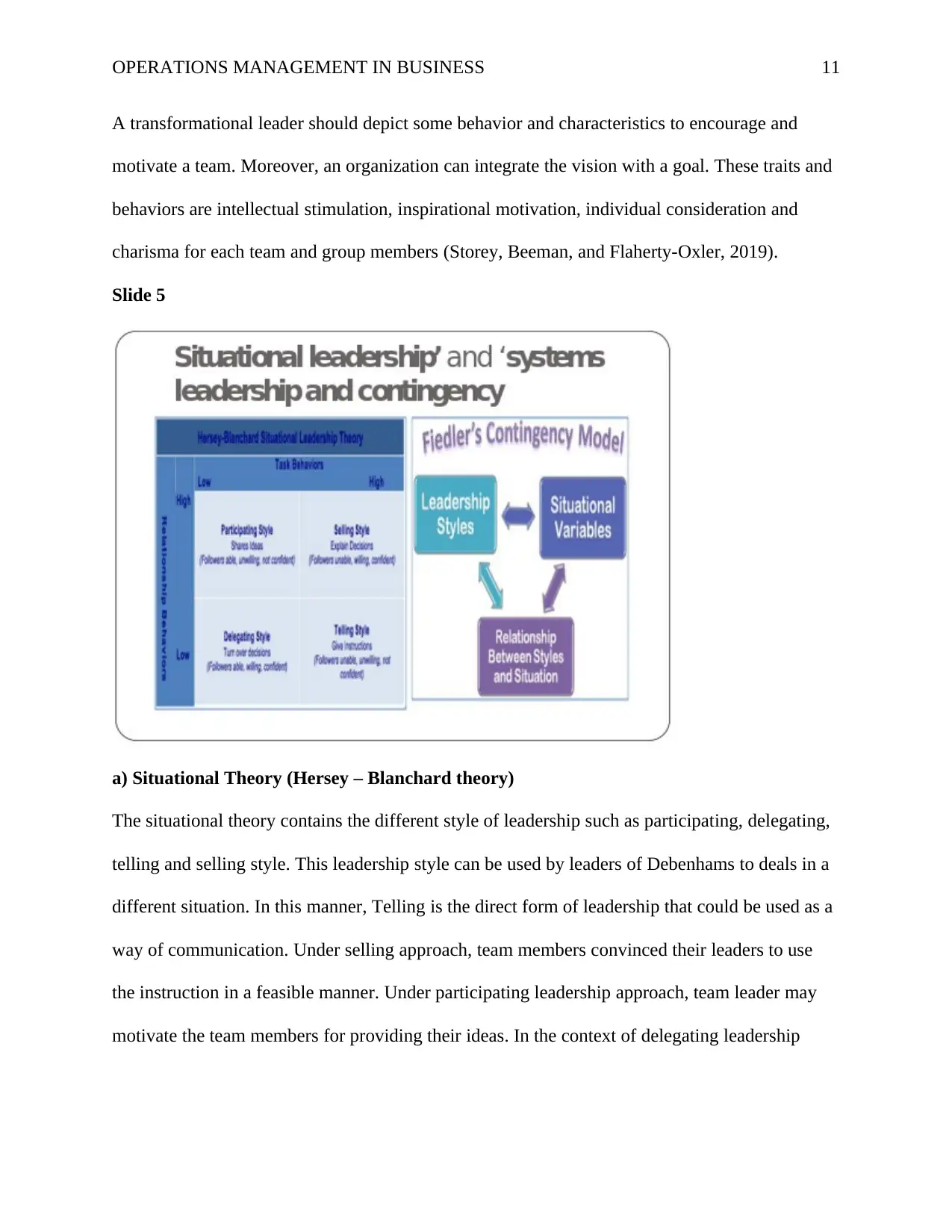
OPERATIONS MANAGEMENT IN BUSINESS 11
A transformational leader should depict some behavior and characteristics to encourage and
motivate a team. Moreover, an organization can integrate the vision with a goal. These traits and
behaviors are intellectual stimulation, inspirational motivation, individual consideration and
charisma for each team and group members (Storey, Beeman, and Flaherty-Oxler, 2019).
Slide 5
a) Situational Theory (Hersey – Blanchard theory)
The situational theory contains the different style of leadership such as participating, delegating,
telling and selling style. This leadership style can be used by leaders of Debenhams to deals in a
different situation. In this manner, Telling is the direct form of leadership that could be used as a
way of communication. Under selling approach, team members convinced their leaders to use
the instruction in a feasible manner. Under participating leadership approach, team leader may
motivate the team members for providing their ideas. In the context of delegating leadership
A transformational leader should depict some behavior and characteristics to encourage and
motivate a team. Moreover, an organization can integrate the vision with a goal. These traits and
behaviors are intellectual stimulation, inspirational motivation, individual consideration and
charisma for each team and group members (Storey, Beeman, and Flaherty-Oxler, 2019).
Slide 5
a) Situational Theory (Hersey – Blanchard theory)
The situational theory contains the different style of leadership such as participating, delegating,
telling and selling style. This leadership style can be used by leaders of Debenhams to deals in a
different situation. In this manner, Telling is the direct form of leadership that could be used as a
way of communication. Under selling approach, team members convinced their leaders to use
the instruction in a feasible manner. Under participating leadership approach, team leader may
motivate the team members for providing their ideas. In the context of delegating leadership
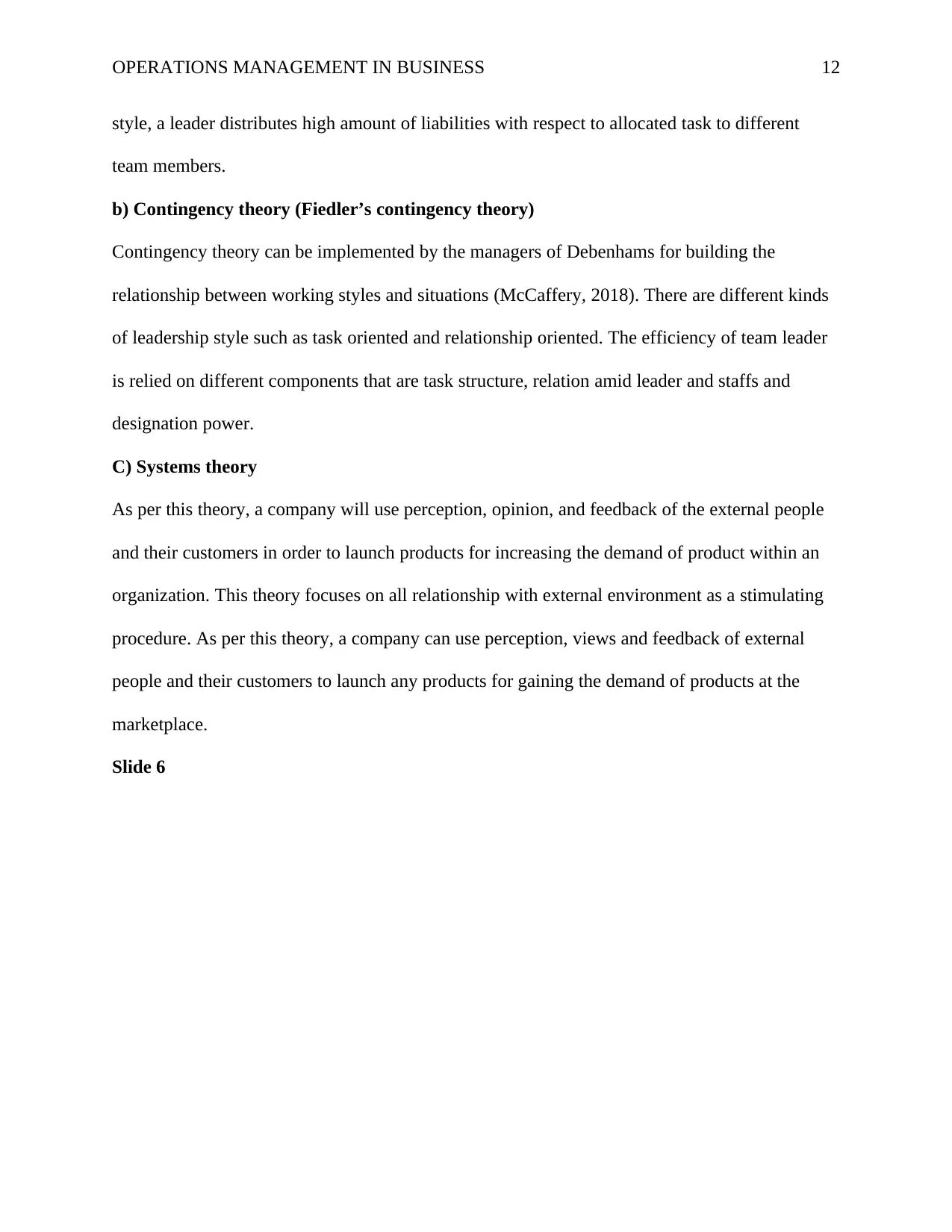
OPERATIONS MANAGEMENT IN BUSINESS 12
style, a leader distributes high amount of liabilities with respect to allocated task to different
team members.
b) Contingency theory (Fiedler’s contingency theory)
Contingency theory can be implemented by the managers of Debenhams for building the
relationship between working styles and situations (McCaffery, 2018). There are different kinds
of leadership style such as task oriented and relationship oriented. The efficiency of team leader
is relied on different components that are task structure, relation amid leader and staffs and
designation power.
C) Systems theory
As per this theory, a company will use perception, opinion, and feedback of the external people
and their customers in order to launch products for increasing the demand of product within an
organization. This theory focuses on all relationship with external environment as a stimulating
procedure. As per this theory, a company can use perception, views and feedback of external
people and their customers to launch any products for gaining the demand of products at the
marketplace.
Slide 6
style, a leader distributes high amount of liabilities with respect to allocated task to different
team members.
b) Contingency theory (Fiedler’s contingency theory)
Contingency theory can be implemented by the managers of Debenhams for building the
relationship between working styles and situations (McCaffery, 2018). There are different kinds
of leadership style such as task oriented and relationship oriented. The efficiency of team leader
is relied on different components that are task structure, relation amid leader and staffs and
designation power.
C) Systems theory
As per this theory, a company will use perception, opinion, and feedback of the external people
and their customers in order to launch products for increasing the demand of product within an
organization. This theory focuses on all relationship with external environment as a stimulating
procedure. As per this theory, a company can use perception, views and feedback of external
people and their customers to launch any products for gaining the demand of products at the
marketplace.
Slide 6
⊘ This is a preview!⊘
Do you want full access?
Subscribe today to unlock all pages.

Trusted by 1+ million students worldwide
1 out of 19
Related Documents
Your All-in-One AI-Powered Toolkit for Academic Success.
+13062052269
info@desklib.com
Available 24*7 on WhatsApp / Email
![[object Object]](/_next/static/media/star-bottom.7253800d.svg)
Unlock your academic potential
Copyright © 2020–2025 A2Z Services. All Rights Reserved. Developed and managed by ZUCOL.





